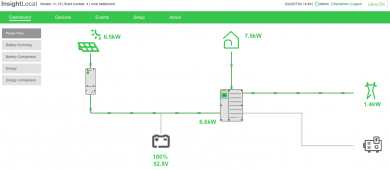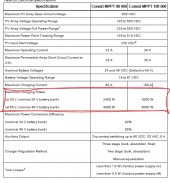scuba_pr
New Member
After some research and help from members of this forum I've decided to start with a 6k Grid-Tie system and expand to 12kWh within 12-18 months. For the inverter I'll be choosing the Schneider Conext XW 6848 with the full Conext PDP as I plan to expand. Battery size will be 20-30kWh but still haven't decide on brand (SOK, Trophy or KiloVault HAB V4 7.5 because UL listing).
Problem now is that I don't know how to properly calculate the panel sizing / connection to the Conext MPPT 100-600. For panels I'm looking into some Q CELLS 480 Bifacial as I have a flat concrete roof with a very reflective white surface. I estimated 13-14 Q CELLS 480 panels needed for 6.2-6.7kWh production. But 14 panels in series @ Voc: 53.39V will be 747.46V far exceeding the MPPT 600V max PV.
After some reading about parallel/series MPPT connections I calculated:
*Note: I'm in warm weather never less than 70 and usually in highs 80-90's. Right now is 79F
Thanks!
Bellow are the specs for the QCell 480 & MPPT 100-600.
Q CELLS 480 Watts (525W with bifacial gain):
Problem now is that I don't know how to properly calculate the panel sizing / connection to the Conext MPPT 100-600. For panels I'm looking into some Q CELLS 480 Bifacial as I have a flat concrete roof with a very reflective white surface. I estimated 13-14 Q CELLS 480 panels needed for 6.2-6.7kWh production. But 14 panels in series @ Voc: 53.39V will be 747.46V far exceeding the MPPT 600V max PV.
After some reading about parallel/series MPPT connections I calculated:
- String 1 (series): 7 PV @ 53.39V = 373.73V @ 11.12A
- String 2 (series): 7 PV @ 53.39V = 373.73V @ 11.12A
- String 1 + String 2 (parallel) = 373.73V @ 22.24A
*Note: I'm in warm weather never less than 70 and usually in highs 80-90's. Right now is 79F
Thanks!
Bellow are the specs for the QCell 480 & MPPT 100-600.
Q CELLS 480 Watts (525W with bifacial gain):
- Vmp: 45.33V
- Imp: 10.59A
- Voc: 53.39V
- Isc: 11.12A
- Maximum System Voltage: 1500V
- Maximum Series Fuse Rating: 20A
- Nominal battery voltage: 24 and 48 VDC
- PV array operating voltage: 195 to 550 VDC
- MPPT voltage range: 195 to 510 VDC
- Max. PV array open circuit voltage: 600V
- Battery voltage operating range: 16 to 67 VDC
- Max. array short circuit current at STC: 35A
- Max. charge current: 100A
- Max. and Min. PV wire size in conduit: #6 AWG to #14 AWG
- Max. output power: 6000 W (nominal 48V systems)










